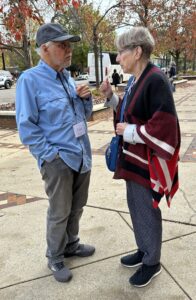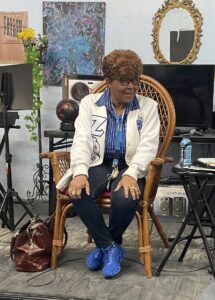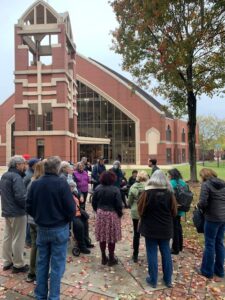 Having been college students in the 1960’s, my husband Alan and I thought we had a very good handle on the struggle for voting rights by our liberal confreres. We marched, signed petitions and voted for folks who were on the right side of the struggle. Being a part of Shomrei’s Civil Right Trip gave us a chance to revisit those memories and reevaluate what it all meant.
Having been college students in the 1960’s, my husband Alan and I thought we had a very good handle on the struggle for voting rights by our liberal confreres. We marched, signed petitions and voted for folks who were on the right side of the struggle. Being a part of Shomrei’s Civil Right Trip gave us a chance to revisit those memories and reevaluate what it all meant.
It was clear to me from the moment Shomrei participated in the Ebenezer Baptist Church service in Atlanta, Georgia until we stood in front of Sixth Street Baptist Church in Birmingham Alabama that no progress would have been made without the impetus of the local Black Churches. The communication backbone of the Church, the shared values of non-violence preached by the clergy, and the safe-haven these Churches provided time after time empowered the marchers, and especially the children.
Lynda Blackmun Lowry, the youngest individual to march across the Edmund Petus Bridge from Selma to Birmingham, met with the Shomrei group in a face-to-face meeting. She reported that her faith in her religion and the justice of their cause impelled her and her friends to go back into the streets after numerous encounters with Sheriff Jim Clark’s goons.
Many of Ms. Lowry’s admirers know her for the heroism on that 53 mile march from Selma to Birmingham when she was only 15 years old. But, for me, the real heroism was in the tenacity it took to go into the fray so many times before the Edmund Petus Bridge march occurred. The first time she was jailed she was 14 years old. She described a scene where the police would let their group march for a  few blocks and then come at them with cattle prods and haul them into a local armory. There they had to stand for hours before release. After one encounter, one hundred boys and girls who had marched were pushed into one jail cell meant for two inmates. As tensions increased, the police continued to haul them into jail and once into an overnight stay in a sweat box. Once behind bars, the children consoled themselves with singing freedom songs.
few blocks and then come at them with cattle prods and haul them into a local armory. There they had to stand for hours before release. After one encounter, one hundred boys and girls who had marched were pushed into one jail cell meant for two inmates. As tensions increased, the police continued to haul them into jail and once into an overnight stay in a sweat box. Once behind bars, the children consoled themselves with singing freedom songs.
After release from jail, the students would return to their Church and started all over again. She wrote in her book Turning 15 on the Road to Freedom, “We learned the drill real quick: We went to jail ; we came back out, and then we went to jail again. Pretty soon we knew to take our bologna sandwiches and peanut butter and jelly sandwiches and cookies and all of the penny candy we could get, because jail food just wasn’t good. ” She was jailed 5 times, and carries scars and 27 stiches from beatings she suffered over those months.
In spite of credible harm to their families, Selma’s parents allowed their children to engage again and again. Hearing Ms. Lowry tell her story, the throughline for the success of this movement was their faith and the physical sanctuary offered by the Black Church. We owe so much to these children … they started a journey which the Shomrei group agreed has not been completed yet. Our take-away, how can we individually find a way to continue the journey envisioned by our forefathers that all men and women are created equal? There is no one answer. Each of us agreed that we have to identify our own path – one that we individually feel comfortable following.
Images: Photos taken by Risa Bernstein and Sarita Eisenberg
- Impressions from the Shomrei Civil Rights Trip - Thu, Jan 11, 2024
- Quiet Heroism in Interfaith Cooperation - Thu, Dec 8, 2016
- Translation – A Path to Tolerance - Thu, Mar 31, 2016

